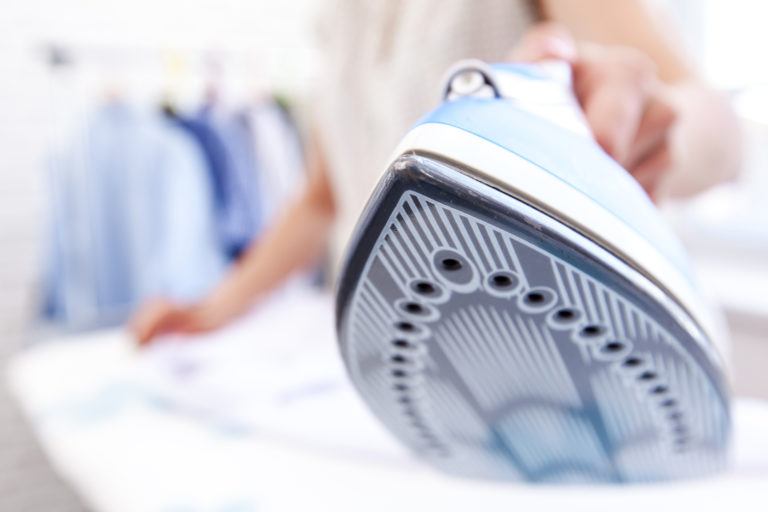
Quick Tips
You set up your ironing board, ready to press your favorite shirt, only to find that your iron is leaving streaks, sticking to fabric, or—worst of all—spitting out weird brown gunk. If your iron is more of a fabric destroyer than a fabric smoother, it’s time for a deep clean. A properly maintained iron makes clothes crisp, presses smoothly, and doesn’t sabotage your outfits.
Why Cleaning Your Iron Matters
Over time, irons accumulate mineral deposits, burnt fabric residue, and gunk from starch sprays. If left unchecked, these buildups can lead to uneven heating, steam blockages, and unwanted stains on your clothes. Cleaning your iron regularly not only improves performance and extends its lifespan, but also ensures your garments look their best without unwanted scorch marks.
What You’ll Need to Clean Your Iron
Before getting started, gather the following supplies:
- Distilled white vinegar – Breaks down mineral deposits.
- Baking soda or salt – A mild abrasive for scrubbing.
- Microfiber cloth – Prevents scratches on delicate surfaces.
- Cotton swabs – Cleans out steam vents.
- Toothpaste (optional) – Works as a gentle polishing agent.
- A bowl of water – For rinsing.
- Paper towels or an old towel – To wipe away residue.
How to Clean an Iron in 6 Steps
1. Unplug and Cool Down First
Safety first—before you do anything, make sure the iron is unplugged and completely cool. Trying to clean a hot iron is a surefire way to burn your fingers or smear gunk around instead of removing it. Once it’s cool, move to a well-ventilated area for the cleaning process.
2. Remove Mineral Buildup from Steam Vents
If your iron isn’t steaming properly, mineral deposits may be clogging the vents. Mix equal parts distilled vinegar and water in a bowl. Dip cotton swabs into the mixture and gently clean each steam hole. For stubborn buildup, use a toothpick or needle, but be careful not to scratch the metal. This step restores proper steam flow and prevents water spots on your clothes.
3. Clean the Soleplate with a Gentle Scrub
For a scorched or sticky soleplate, sprinkle baking soda or salt onto a damp microfiber cloth. Gently rub the surface in small circular motions to lift burnt-on residue. If the grime is extra stubborn, apply a small dab of toothpaste, let it sit for a minute, and buff it out. Wipe with a clean, damp cloth to remove any remaining particles. This step prevents fabric damage and keeps the iron gliding smoothly.
4. Deep Clean the Water Reservoir
If your iron is spitting out rust-colored water or has a lingering odor, the reservoir likely has mineral buildup. Fill the tank with a 50/50 mix of white vinegar and distilled water. Turn the iron on to its lowest steam setting and let it steam for 5 minutes over a sink or old towel. Then, unplug the iron, let it cool, and drain the reservoir. Fill it again with clean water, steam for another few minutes, and empty it to remove any leftover vinegar. This step prevents mineral deposits from affecting your clothes.
5. Wipe Down the Exterior and Cord
Your iron’s exterior also needs love! Wipe the housing, handle, and cord with a damp microfiber cloth. If there are sticky spots, a little bit of vinegar will do the trick. Keeping the exterior clean prevents dirt from transferring onto clothes and ensures a better grip while ironing.
6. Run a Final Test on an Old Towel
Before using your iron on real clothes, run a final test on an old towel. Set the iron to a medium heat setting and glide it over the towel in circular motions. This helps remove any last traces of cleaning solution and ensures your iron is back to peak performance.
How Professionals Maintain Irons
Iron maintenance isn’t just for DIYers—professionals follow these key practices:
- Using only distilled water – Prevents mineral deposits from forming.
- Cleaning after heavy starch use – Starch buildup can clog vents and burn onto the plate.
- Regularly emptying the reservoir – Prevents mold and musty odors.
- Polishing the soleplate with a microfiber cloth – Keeps the surface smooth and residue-free.
If your iron is beyond cleaning or continues to leak or overheat, it might be time to invest in a replacement (best steam irons for home use).
How Often Should You Clean Your Iron?
- Light cleaning: Every 1–2 weeks if you use your iron frequently.
- Deep cleaning: Every 1–2 months if you notice steam issues or residue.
- After starch use: Immediately after to prevent buildup.
- Reservoir flush: Every few months to prevent mineral deposits.
Final Thoughts
A clean iron means crisp, fresh clothes without frustrating stains or sticky spots. By following these simple steps, you’ll keep your iron working efficiently and extend its lifespan.
For more appliance cleaning tips, check out How to Clean a Washing Machine. Keep your laundry tools in top shape and your clothes looking their best!